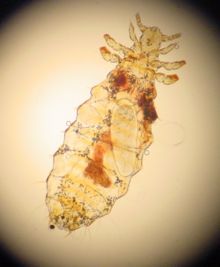Sucking louse
From Wikipedia, the free encyclopedia
| Sucking lice | |
|---|---|
 |
|
| Linognathus setosus (Linognathidae) | |
| Scientific classification | |
| Kingdom: | Animalia |
| Phylum: | Arthropoda |
| Class: | Insecta |
| Subclass: | Pterygota |
| Infraclass: | Neoptera |
| Order: | Phthiraptera |
| Suborder: | Anoplura Leach, 1815 |
| Diversity | |
| 15 families | |
| Synonyms | |
|
Siphunculata |
|
The Anoplura are all blood-feeding ectoparasites of mammals. They can cause localised skin irritations and are vectors of several blood-borne diseases. Children appear particularly susceptible to attracting lice, possibly due to their fine hair.
At least three species of Anoplura are parasites of humans; the human condition of being infested with sucking lice is called pediculosis. Pediculus humanus is divided into two subspecies, Pediculus humanus humanus, or the body louse, sometimes nicknamed "the seam squirrel" for its habit of laying of eggs in the seams of clothing, and Pediculus humanus capitis, or the head louse. Pthirus pubis (the crab louse) is the cause of the condition known as crabs.
Families
The following 15 families are generally recognized in the Anoplura:- Echinophthiriidae – seal lice
- Enderleinellidae
- Haematopinidae – ungulate lice
- Hamophthiriidae
- Hoplopleuridae – armoured lice
- Hybothiridae
- Linognathidae – pale lice
- Microthoraciidae
- Neolinognathidae
- Pecaroecidae
- Pedicinidae
- Pediculidae – body lice
- Pthiridae – pubic lice
- Polyplacidae – spiny rat lice
- Ratemiidae
Комментариев нет:
Отправить комментарий